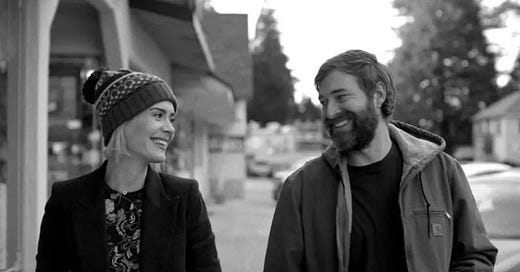Occasionally, the on-screen chemistry between actors is so strong that it’s hard to believe they aren’t romantically involved off-camera. It makes me wonder what their real-life partners must be like to measure up to the emotional depth and intimacy they portray. Blue Jay is a prime example in this regard, as the connection between Jim (Mark Duplass) and Amanda (Sarah Paulson) feels so authentic that it almost erases the boundary between fiction and reality.
The plot is built around a simple premise: two former high school sweethearts run into each other in a grocery store of their sleepy hometown. This sparks a spontaneous day spent reminiscing and uncovering the emotional debris left in the wake of their youthful love, loaded with the kind of emotional weight that only time—and unspoken regret—can create.
Its style is akin to Richard Linklater’s Before trilogy, with clear mumblecore influences woven throughout. It’s wrapped with the use of black-and-white cinematography and melancholic piano music, which feels completely unnecessary, given the already somber backstory. These stylistic choices steer the viewer too deliberately toward sadness, subtly manipulating their emotions. The story and performances evoke enough feeling on their own, so a more restrained approach would have allowed the film’s emotional weight to resonate more authentically. Less would have been more.
The raw chemistry between Jim and Amanda—dare I say Duplass and Paulson—is magnetic, and the dialogue—much of it improvised—feels disarmingly authentic. However, it borders on the implausible at times due to the intense intimacy they quickly reignite. As they indulge in the enjoyable recollection of their past, slipping into old patterns, old jokes, and even recreating some old situations, you sense an undercurrent of pain beneath the laughter. You realize almost immediately that this isn’t just a catch-up between old flames; it’s a reckoning.
We often underestimate the extent to which others have shaped our lives, yet their influence never fully disappears. It lingers quietly and stubbornly, always just below the surface. We tend to realize this once that person is gone, and when that happens, it’s devastating. Blue Jay explores how all those nostalgic fragments of youth and love can warp our expectations of the present. It shows how they can make future happiness feel unreachable or irrelevant because nothing ever feels quite the same again. Amanda and Jim pretend to overcome this feeling while quietly denying it, which raises the unavoidable question and the crux of the plot: How on earth are these two not together? Even though their lives have taken separate paths, it’s painfully obvious that their comfort zone has always been each other. However, the answer clearly states that the wound is too deep to ever heal. Blue Jay is not about rekindling what was lost, but rather acknowledging that it existed—that it mattered—and accepting that its ghost will haunt them forever.
For anyone who has ever wondered “what if?“, Blue Jay is a poignant and aching reminder that some feelings never truly fade.





